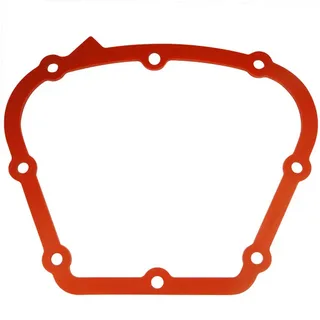Maintaining your vehicle’s Rocker Valve Cover Gasket ensures your engine runs smoothly and efficiently. This crucial component helps prevent oil leaks and retains your engine’s overall health. By understanding the importance of this gasket and implementing a few simple maintenance tips, you can extend its life and keep your engine in top shape. Regularly inspecting the gasket for any signs of wear or damage is a good starting point, as early detection can prevent costly repairs. Additionally, ensuring the bolts are properly torqued can help maintain a secure seal, reducing the likelihood of oil leaks.
Understanding the Valve Cover Gasket
The valve cover gasket, sometimes called a rocker cover gasket, is a critical component in an engine’s structure. It serves as a seal between the valve cover and the engine cylinder head, preventing oil leaks and ensuring the engine operates efficiently.
Purpose and Function
The primary role of a valve cover gasket is to keep engine oil contained within the cylinder head and valve train area. As the engine operates, oil circulates to lubricate various parts, reducing friction and heat. The gasket creates a reliable seal, preventing oil from leaking out, which helps maintain the oil levels necessary for proper engine function and reduces the risk of oil seeping into other parts of the engine.
Types of Valve Cover Gaskets
Valve cover gaskets are typically made of materials like rubber, silicone, or cork, each offering different levels of durability and flexibility. Rubber gaskets are common due to their flexibility and affordability, while silicone gaskets can withstand higher temperatures and are often preferred for performance vehicles. Cork gaskets are less common today but may still be used in vintage engines.
Signs of a Faulty Valve Cover Gasket
Over time, the valve cover gasket may wear down due to high heat and pressure exposure, leading to leaks. Signs of a failing gasket include oil stains under the vehicle, a burning oil smell, and low oil levels. Ignoring these signs can lead to severe engine damage, making it essential to promptly replace a faulty valve cover gasket.
Common Signs of a Failing Rocker Cover Gasket Replacement
The rocker cover gasket, or the valve cover gasket, is a crucial seal between the engine’s rocker cover and cylinder head. Over time, wear and tear can cause this gasket to fail, leading to various issues. Recognising these signs early can help prevent more costly repairs and engine damage.
1. Oil Leaks
One of the most common signs of a failing rocker cover gasket is visible oil leakage. When the gasket wears out or becomes brittle, oil may seep and accumulate on top of the engine. You may notice oil puddles under the car, particularly after it has been parked for a while. This oil leak can also reach other engine components, causing damage if not promptly addressed.
2. Burning Oil Smell
A worn-out rocker cover gasket may allow oil to drip onto hot engine parts, such as the exhaust manifold, leading to a distinct burning oil smell. This smell can become noticeable while driving or shortly after parking, and if left unchecked, it may even lead to smoke from the engine bay, creating a potential fire hazard.
3. Engine Misfires and Performance Issues
Oil leakage from a faulty gasket can interfere with spark plug performance if the oil seeps into the spark plug wells. This interference can lead to misfires, poor engine performance, and rough idling. Addressing the gasket issue can prevent these symptoms and protect engine health.
4. Low Oil Levels
A leaking gasket can cause a gradual drop in engine oil levels, which may go unnoticed initially. Regularly checking and topping off oil is essential, but if you frequently add oil, inspect the gasket as a potential culprit.
Replacing a failing rocker cover gasket replacement is necessary to ensure optimal engine performance and longevity. If you detect any of these symptoms, consult a mechanic for inspection and timely replacement.
Maintenance Tips for the Gasket Rocker
Maintaining the rocker cover gasket, also known as the valve cover gasket, is essential for the engine’s overall health. This gasket sits on top of the engine and seals the rocker cover, preventing oil leaks from the cylinder head and protecting the engine from contaminants. Proper care can extend the gasket’s life and maintain engine performance.
Inspect for Leaks Regularly
The primary job of the rocker cover gasket is to keep oil inside the engine. Over time, due to engine heat and pressure, gaskets can become brittle and crack, leading to oil leaks. Regularly inspect the area around the rocker cover for signs of oil leaks, such as oil stains or a burning smell when the engine is running. Early detection of a leak can prevent oil loss and reduce the risk of engine damage.
Clean the Rocker Cover and Gasket Area
Dirt and debris around the gasket rocker cover can worsen oil leaks and clog the gasket area, reducing its effectiveness. When performing routine maintenance, clean the rocker cover and surrounding area. Use a degreaser and a clean rag to remove grime. Avoid excessive water, which may seep into the engine, causing further issues.
Replace the Gasket as Needed
Rocker cover gaskets are made of rubber or cork, which degrade over time. If you notice consistent oil leaks despite tightening the rocker cover bolts, it’s likely time for a gasket replacement. Gasket replacements can vary in difficulty, so consulting a professional or following a step-by-step guide can help ensure proper installation.
Regular Maintenance Reduces Costs
Maintaining the rocker cover gasket can save time and money by preventing oil loss, protecting other engine parts, and avoiding costly repairs. By regularly inspecting, cleaning, and replacing the gasket as needed, you can extend the life of your engine and improve overall vehicle reliability.
How to Replace a Faulty Gasket?
Replacing a faulty gasket is straightforward and can prevent leaks and improve engine performance. Here’s a step-by-step guide to help you replace a gasket efficiently.
1. Gather Necessary Tools and Supplies
Before beginning, ensure you have the correct replacement gasket for your specific vehicle and any necessary tools, such as a wrench set, screwdriver, gasket scraper, and gasket sealant. Additionally, a clean rag or degreaser can help clean the surfaces before installing the new gasket.
2. Remove the Component with the Gasket
Identify the part where the gasket is located, such as the valve cover or oil pan. Carefully use the appropriate tools to remove the bolts and lift the part from the engine. Place the bolts aside in a safe spot for reassembly.
3. Clean the Surfaces
Once the component is removed, carefully scrape off any remnants of the old gasket with a gasket scraper or plastic putty knife. Be thorough, as any debris left on the surface can prevent a proper seal. Use a rag and degreaser to clean both surfaces, ensuring they are completely dry before applying the new gasket.
4. Apply Gasket Sealant (If Needed)
If the gasket requires sealant, apply a thin layer on both sides. Be careful not to use too much; excess sealant can squeeze out and interfere with the engine’s operation. Place the new gasket onto the cleaned surface.
5. Reassemble and Tighten
Once the gasket is in place, carefully align the component onto the engine and replace the bolts. Tighten them gradually in a crisscross pattern to ensure even pressure. Refer to the manufacturer’s torque specifications to avoid overtightening.
Choosing the Right rocker cover replacement
Selecting the right cover replacement is crucial when maintaining your vehicle’s engine. The rocker cover, also known as the valve cover, plays a significant role in sealing the upper part of the engine, protecting it from contaminants while ensuring proper oil circulation. Here are some key factors to consider when choosing a replacement.
Material Matters
Rocker covers are typically made from aluminum, plastic, or composite materials. Aluminum covers are durable and can withstand higher temperatures, making them ideal for high-performance engines. Plastic covers are lighter and often more affordable, but they may not hold up as well under extreme conditions. Composite materials offer a balance between weight and strength.
Compatibility and Fit
Before purchasing a rocker cover, ensure it is compatible with your engine model. Check the manufacturer’s specifications and part numbers to avoid any fitting issues. An ill-fitting rocker cover can lead to oil leaks, performance issues, and potential engine damage.
Quality and Brand Reputation
Opt for replacements from reputable manufacturers to ensure you’re getting a quality product. Reviews and recommendations can guide you toward reliable brands known for their durability and performance.
Installation Considerations
Finally, consider whether you’ll install the rocker cover yourself or seek professional help. Some covers come with all the necessary gaskets and hardware, making installation easier for DIY enthusiasts. Proper installation is critical to prevent leaks and maintain engine performance.
By carefully considering these factors, you can ensure a successful rocker cover replacement that enhances your engine’s longevity and efficiency.
Preventing Future Valve Cover Gasket Issues
Valve cover gaskets play a crucial role in sealing the valve cover to the engine, preventing oil leaks and ensuring optimal engine performance. However, over time, these gaskets can deteriorate due to heat, age, and exposure to oil. To avoid future gasket issues, regular maintenance and proactive measures are essential.
One of the most effective ways to prevent valve cover gasket problems is through routine inspections. Regularly check for signs of oil leaks around the valve cover area. If you notice an oil buildup or a burning smell, it may indicate a failing gasket. Addressing these symptoms early can save you from costly repairs down the line. Additionally, monitor engine temperature; excessive heat can accelerate gasket degradation.
Another critical preventive measure is using the correct torque specifications when reinstalling the valve cover. Over-tightening can cause the gasket to compress too much, leading to premature wear, while under-tightening may result in insufficient sealing. Refer to your vehicle’s service manual for the recommended torque settings to ensure a proper fit.
Choosing high-quality replacement gaskets is also vital. Many aftermarket gaskets are available, but not all offer the same level of durability. Opt for gaskets made from advanced materials such as silicone or rubber, providing better heat and oil exposure resistance.
Lastly, regular oil changes can contribute significantly to the longevity of your valve cover gasket. Clean oil helps reduce the build-up of contaminants that can break down the gasket material over time. By maintaining a consistent oil change schedule, you not only protect the gasket but also enhance overall engine health.
Conclusion
Regular inspections, promptly addressing any signs of wear, and the use of high-quality materials can significantly extend the lifespan of your Rocker Valve Cover Gasket. Ensuring the gasket and surrounding components are clean and debris-free will help maintain an effective seal. Proper installation techniques, such as avoiding over-tightening bolts and using the right tools, are crucial for optimal performance. Additionally, choosing a reputable brand for your gasket replacement ensures durability and reliability. Keeping an eye on your engine’s overall health, including using quality oil and maintaining the cooling system, can prevent premature gasket failure.
FAQS
Q: How often should I inspect my Rocker Valve Cover Gasket?
A: Inspecting your Rocker Valve Cover Gasket during routine oil changes or at least every 10,000 miles is recommended. Regular inspections can help catch any early signs of wear or damage.
Q: Can I use any gasket sealer on my Valve Cover Gasket?
A: Only use gasket sealer if recommended by your vehicle manufacturer. Some gaskets are designed to be installed dry, and using a sealer could compromise their effectiveness.
Q: What materials are best for Valve Cover Gaskets?
A: Rubber and cork are common materials for Valve Cover Gaskets. Rubber is flexible and easier to install, while cork provides excellent sealing properties. Consult your vehicle’s manual for specific recommendations.
| Related Business Listings |
| Contact Directory |
| Local Business Profiles |






